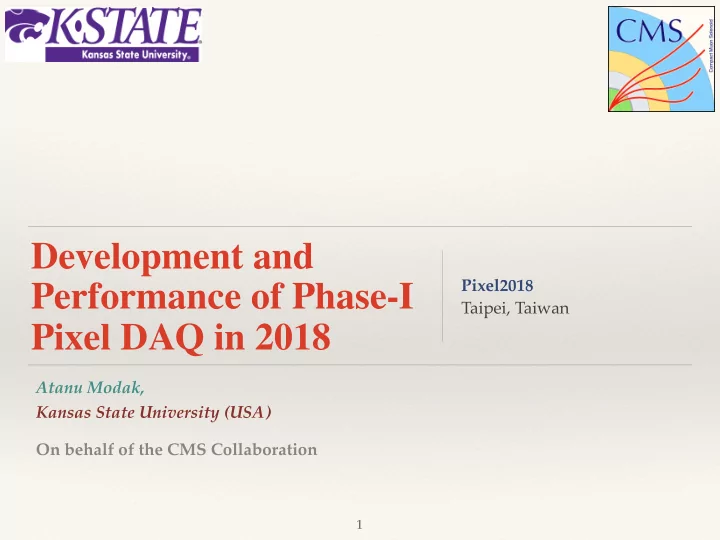

Development and Pixel2018 Performance of Phase-I Taipei, Taiwan Pixel DAQ in 2018 Atanu Modak, Kansas State University (USA) On behalf of the CMS Collaboration � 1
Outline ❖ Pixel Detector ❖ DAQ System ❖ Pixel Online Software ❖ Firmware development ❖ Soft Error Recovery ❖ Monitoring ❖ Long Shutdown 2 Plans ❖ Summary � 2
Phase-I Pixel Upgrade Long Shutdown 2 LHC Run-2 Starts Starts 2015 2016 2017 2018 2019 2020 Phase-I Upgrade Of End of LHC Run-2 Pixel Detector ❖ Pixel detector with one additional barrel layer and end-cap disc after Phase-I upgrade ❖ New front-end readout chip to cope with the higher particle hit rates ❖ Moved from 40 MHz Analog to 160 MHz Digital readout ❖ uTCA based backend DAQ to handle increased number of readout channels, higher data rate and new digital data format � 3
Front-end Layout of the read out chip (ROC) Token Bit Manager (TBM) block diagram 80 rows x 26 double columns = 4160 Pixels Double Column Periphery Time Stamp Buffer, Data Buffer ❖ 160 MHz digital readout scheme Control interface ❖ 2:1 multiplexed, 4-to-5 bit encoded data stream ❖ 8 bit ADC ❖ 2x160 Mbps from TBM cores A&B to 320 Mbps output ❖ Increased buffer size for timestamp (24) and data (80) Schematic of a typical module ❖ Digital data transmission ❖ Digital readout at 160 MHz � 4
Pixel DAQ Architecture � 5
Pixel DAQ Hardware ❖ Pixel backend DAQ is based on Micro Telecom Computing Architecture (uTCA) standard ❖ Front-end drivers (FED) and Front-end Controllers (FECs) have custom uTCA cards based on FC7 ❖ Same hardware, different firmware ❖ Optical mezzanine • Tracker FEC: Program auxiliary electronics (CCU, Portcard, Opto-hybrids etc) • Pixel FEC: Distribute clock, trigger, fast signals to modules. Program Modules • Pixel FED: responsible for data read out from modules and transfer it to central DAQ FC7 Back FED Mezzanine FEC Mezzanine FC7 Front � 6
Pixel DAQ Backend layout PixelFECs FEDs TrackerFEC FPix BPix BPix � 7
Pixel Online Software Software Structure � 8
Firmware There were two major developments on firmwares in 2018 ❖ Pixel FEC firmware upgrade ❖ Pixel FED firmware upgrade for Heavy Ion physics � 9
Pixel Front-end Controller ❖ Segmented DDR3 memory structure ❖ Store module configuration data in DDR3 memory locally Replaced by Segmented DDR3 � 10
Segmented Memory ❖ Write different type of commands in designated memory ❖ Send out in parallel per channel Memory overwritten for each command Commands are stored in Segmented memory Commands are stored in Segmented memory � 11
Pixel FEC Performance 1856 Module x 16 ROC x 4160 Pixel Total configuration time reduced dramatically Faster Module configuration has direct impact due to PixelFEC firmware upgrade on detector operation � 12
Front-end Driver Firmware ❖ There are two parts of the FED firmware, front-end and back-end Scheme for FED frontend firmware Scheme for FED backend firmware New Parallel Readout Spy data to monitor error FED only receives trigger when in RDY state FED can have 3 possible states: ❖ Ready (RDY) ❖ Busy (BSY) ❖ Out of Sync (OOS) � 13
FEROL Throughput New firmware saturates the link Starts throttling FED throughput from Slink to FEROL. Solid line is the throughput, while the dotted line is the measured trigger rate. The blue (red) triangles are the throughput of simulations with a pile-up of 70 (130) � 14
Soft Error Recovery (SER) ❖ Automatic recovery from Single Event Upset (SEU) ❖ Pixel is close to the interaction point, higher SEU rate Recovery Scheme: Software Scheme: Channel reported by FED as auto-masked • with first FixingSoftError -> Reprogram Module • Channel reported by FED as auto-masked • with second FixingSoftError -> Reprogram Module • Channel reported by FED as auto-masked • with third FixingSoftError -> blacklist (no data) • Configurable threshold to trigger SER More complete and quicker module configuration during soft error recovery ❖ Full Configuration: Pixel level programming, ~66kB data/module ❖ Partial Configuration: ROC level programming, ~0.5kB data/module � 15
Monitoring (I) ❖ Monitoring is extremely important to spot problems FED Monitor: ❖ FED Rack overview Detailed error summary for all channels in a FED ❖ Individual FED overview ❖ Channel wise details fer FED ❖ Powerful tool to diagnose problems Error overview of a single FED summed over all channels � 16
Monitoring (II) AMC13 Monitor: Online Readback of Read Out Chip: ❖ AMC13 status monitoring ❖ Live status of ROC properties ❖ Status of individual slots in a crate ❖ Helps to figure out offending slot Readback bits are part of the 0SD Bits data format (ROC header) Readback DAC settings: {Va, Vd, Vana, Vbg, Iana} ❖ There are various other tools which helped towards the smooth running of the detector in 2018 � 17
LS2 Plans ❖ During detector operation period not much scope for software restructuring ❖ LS2 provides the opportunity for long term development ❖ Goal is to make the software easier to maintain, develop and improve monitoring ❖ Massive cleanup of the software on the card ❖ Keep it XDAQ compatible ❖ Plan for new UI for different applications, added monitoring ❖ Configuration from database ❖ Firmware development for FED and FEC ❖ Use existing test setups for development purposes � 18
Summary ❖ We had a productive year of operation in 2018 ❖ No major issues ❖ Minimal data loss (5%) due to problem in Pixel DAQ, stable performance ❖ Developed new FED and FEC firmware ❖ DDR FEC firmware improved the configuration timing drastically, enabled to write the full configuration to front-end frequently ❖ Parallel draining improved the FED throughput significantly, also will be used after LS2 ❖ Successfully dealt with the operation (daq) related issues as they appeared ❖ We will be using the same Pixel DAQ (backend) system in LHC Run 3 ❖ Entering Long Shutdown 2 aiming for a major change in pixel online software � 19
Recommend
More recommend